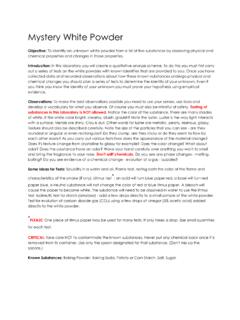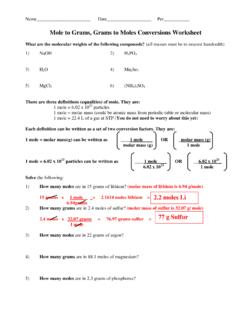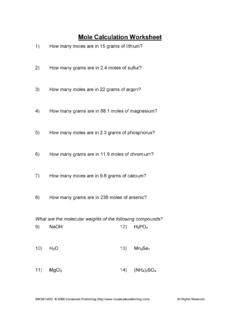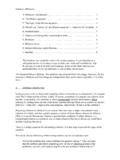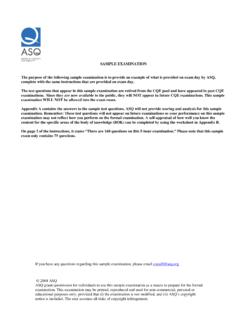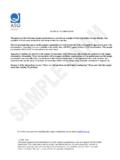Transcription of WORKSHEET:SOLUTIONS AND COLLIGATIVE PROPERTIES …
1 WORKSHEET:SOLUTIONS AND COLLIGATIVE PROPERTIES SET A: 1. Find the molarity of all ions in a solution that contains moles of aluminum chloride in 820. ml solution. Answer: [Al 3+]= M , (Cl-] = 2. Find the molarity of each ion present after mixing 27 ml of M HNO3 with 36 ml of M Ca(NO3)2 (Note: There is no reaction taking place.) Answer: [H+]= M, [NO3-]= , [Ca2+]= M . 3. Find the molarity of each ion present after mixing 35 ml of M K2SO4 with 27 ml of K3PO4. Answer: [K +] = M, [SO42-]= M, [PO4 3-]= M. 4. Calculate the concentration of each ion and the mass of any precipitate when a mole of aluminum hydroxide is added to ml of M nitric acid solution ( Assume that there is no volume change upon the addition of the aluminum hydroxide to the solution). Hint: Write a balanced equation for the reaction taking place. Answer: 20 g Al(OH)3 left over, [Al3+]= M, [NO3-]= 5.)
2 A solution consists of g benzene,C6H6 , and g toluene ,C6H5CH3. The vapor pressure of pure benzene at 20. C is 75 mm Hg and that of toluene at C is 22 mm Hg. Assume that Raoult s law holds for each component of the solution, calculate the mole fraction of benzene in the vapor. ( molar mass of benzene= g/mole and toluene = g/mole.) Answer= 6. The freezing point of a glucose solution ( C6H12O6;molar mass= g/mole) is - C . The density of the solution is g/ml. What is the molarity of the glucose solution? ( Kf for water is ) Answer: mole/L 7. What is the normal boiling point of a M solution of KBr that has a density of g/ml?( KB for H2O is C .kg/mole) Answer=: C 8. ml of M potassium carbonate solution is mixed with ml of M cobalt(III) chloride a. Write a balanced equation for the reaction. b. Write the total-ionic and net-ionic equations for the above reaction.
3 Total ionic: Net-ionic: c. Give the name and mass of any precipitate(s)that may have formed. Answer: g of Co2(CO3)3 precipitate. Calculate the molar concentration of each ion remaining in solution after the reaction is complete. Answer:concentration of potassium ions= M, concentration of cobalt (III) ions= M concentration of carbonate ions= 0 M concentration of chloride ions= M SET B: 1. A solution that contains g of a nonvolatile nondissociating solute in 400. g of benzene freezes at C . The normal freezing point of benzene is C. What is the molar mass of the solute? ( KF for benzene= C .kg/mole) Answer: 82 g/mole 2. Chloroform and methanol form an ideal solution. The solution boils at 22 C and atm . At 22 C , the vapor pressure of pure methanol is atm and the vapor pressure of pure chloroform is atm. What is the mole fraction of chloroform in the solution?
4 Answer: 3. What is the normal boiling point of M solution of CaI2 that has a density of g/ml? ( KB for H2O = C .kg/mole) Answer: C 4. Calculate the freezing point of a % by mass Na3PO4 solution. ( Kf for H2O = C .kg/mole) Answer: C 5. ml of M aluminum nitrate is mixed with ml of M sodium carbonate and allowed to react. a. Write a balanced equation for the reaction. b. Write total-ionic and net-ionic equations for the above reaction. Total-ionic: Net-ionic: c. Give the name and mass of any precipitate that may have formed. Answer: g of Al2(CO3)3 precipitate d. Calculate the molar concentration of each ion remaining in solution after reaction is complete. Answer: Concentration of carbonate ions= 0 M Concentration of aluminum ions = M Concentration of nitrate ions= M Concentration of sodium ions = M SET C: 1.
5 What is the molarity of an aqueous solution of C6H12O6 that has a normal boiling point of C and density of g/ml? KB for water is C .kg/mole. ( C6H12O6 is a nonvolatile nondissociating solute.) Answer: mole/L 2. Calculate the normal freezing point of a M aqueous solution of C12H22O11 that has a density of g/ml. ( C12H22O11 is a nonvolatile nondissociating solute.) The molal freezing point depression constant of water is C .kg/mole. Answer: Freezing point= C 3. Heptane, C7H16, and octane,C8H18, form an ideal solution. At 40. C , the vapor pressure of pure heptane is atm , and the vapor pressure of pure octane is atm. A solution is made of g heptane and g octane. Calculate the mole fraction of octane in the vapor at the above temperature. Answer: 4. What is the molar mass and molecular formula of a nondissociating compound whose empirical formula is C4H2N , if g of the compound in 500.
6 G benzene give a freezing point depression of C? ( The molal freezing point depression constant for benzene is C .kg/mole.) Answer: 128 g/mole; C8H4N2 5. Liquids A and B form an ideal solution. The vapor pressure of pure A is atm at the normal boiling point of a solution prepared from mole of B and mole of A. What is the vapor pressure of pure B at this temperature? Answer: atm 6. A L aqueous solution contains g of a protein. The osmotic pressure of the solution is torr at 25 C. What is the molar mass of the protein? Answer: x 104 g/mole 7. Acetone and methanol form ideal solution. At 25 C, the vapor pressures of pure acetone and pure methanol are atm and atm respectively. Calculate the mole fraction of methanol in a solution that boils at 25 C and atm. Answer: X=



